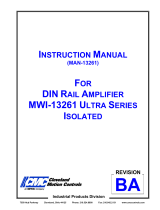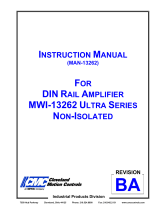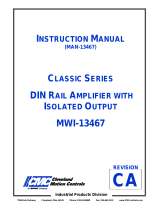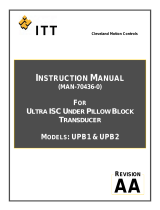Page is loading ...

HI 2204LT Loop Powered Level Weight Transmitter
OPERATION AND INSTALLATION
MANUAL
Corporate Headquarters
9440 Carroll Park Drive
San Diego, CA 92121
Phone: (858) 278-2900
FAX: (858) 278-6700
Web-Site: http://www.hardysolutions.com
Hardy Process Solutions Doc. Number: 0596-0138-01 Rev F
Copyright 1999 to 2013 Hardy Process Solutions All Rights Reserved. Printed in the U.S.A. (941028)

1-2

Table of Contents
i
Table of Contents
Overview 1
Specifications 2
Physical Dimensions 2
Power Requirement 2
Load Cell Excitation 2
Zero Offset Range 2
Sensitivity 2
Linearity 2
Operating Temperature Range 2
Temperature Coefficient 3
Signal Current Ripple 3
Power Supply Rejection 3
Approvals HI 2204LT 3
Installation 3
Junction Box with Strain Gage Summing Board 3
Input - Strain Gage Transducer 4
Output/Power Loop 4
Earth Ground and Signal Return 5
Precautions on Grounding 6
Isolation 7
Calibration 7
Calibration Controls 8
Coarse (Zero) 8
Fine (Zero) 8
Span 8
Calibration Procedures 8
Example 9
Trouble Shooting Procedures 10
Malfunction: No Output 10
Malfunction: No Change in Input 10
Malfunction: Output Drifts 10

HI 2204 LT
ii

HI 2204LT
1
Overview The model HI 2204LT Loop Powered Level Weight
Transmitter furnishes power to strain gage transduc-
ers, measures the return voltage, and adjusts the 4-20
milli amp loop current to be proportional to the trans-
ducer signal.
The HI 2204LT is not Factory Mutual approved and
should not be used in a hazardous environment.
The HI 2204LT can be used to transmit any strain
gage signal with a bridge resistance of more than 88
ohms. This allows transmission of pressure, load,
weight, force and torque signals including up to four
350 ohm, full bridge, load cells.
The HI 2204LT powers itself and the attached strain
gage transducers from the 4-20 ma loop power. This
allows sensitive strain gage signals to be transmitted
over long distances without the expense of installing
additional power to remote locations. A common,
low-cost power supply can be placed anywhere in the
4-20 ma loop.
As the power supply provides loop power, the HI
2204LT controls the current flow (4-20 ma) represent-
ing the strain gage signal and receiving devices can be
placed anywhere along the loop to monitor current
flow. Typical receiving devices include:
• Chart Records
•Panel Meters
• Bar Graphs
• Programmable Controllers
• Computers
• Relay Set Point Modules
Most receiving devices may be characterized as a load
resistor allowing the 4-20 ma signal to cause a propor-
tional voltage drop across it. Multiple receivers may
be placed on the loop provided the loop power supply
can drive the combined loads. this can be calculated
by adding the voltage requirements of the HI 2204LT
(14 VDC) to that of each receiving device (loop resis-
tance x 20 ma).

HI 2204LT
2
The transmitter applies power to each transducer in
pulses a few milliseconds long at a rate of 90 pulses
per second. The transmitter measures the voltage
across the output terminals of the transducer with
each power pulse, and it converts the average into a
smooth current that varies with the transducer signal.
This method of powering the transducer allows the
transmitter to power up to four load cells. Though
each load cell requires more than 4 ma excitation, the
transmitter itself draws no more than 4 ma average
current at zero weight load, and no more than 20 ma
average current at full scale.
The transmitter is potted and sealed to withstand typi-
cal industrial environments. It is small enough to be
mounted on a load cell summing board inside of a
standard 5” x 7” x 3.5” NEMA 4 enclosure.
Specifications
Physical
Dimensions Length: 4.50 Inches (114.3 mm)
Width: 2.15 Inches (54.6 mm)
Height: 1.30 Inches 33.02 mm)
Weight: 8 oz. (.227 Kgs)
Power
Requirement Minimum: 15 VDC
Maximum: 50 VDC
Zero Scale: 4 ma
Full Scale: 20 ma
Load Cell
Excitation 5 V (pulsed)
Zero Offset Range Coarse: 2 mV/V
fine: 0.04 mV/V
Sensitivity 3 mV/V (Continuously Adjustable from 1 mV/V to 3
mV/V)
Linearity 0.08% of full scale
Operating
Temperature
Range
0o C to +60o C (+32o F to +140o F)

HI 2204LT
3
Temperature
Coefficient 0.025% per degree Celsius
Signal Current
Ripple 20 mV p-p at 20 ma into 500 ohms
Power Supply
Rejection 0.015% (max) 20 to 30 V
0.10% (max) 15 to 50 V
Approvals
HI 2204LT CE
Installation The Loop Powered Level Weight Transmitter is usu-
ally installed close to the strain gage(s) to minimize
the expense of special wiring, such as load cell cable.
Wiring positions are indicated on the top surface next
to each terminal strip.
Junction Box with
Strain Gage
Summing Board
The transmitter is available in a NEMA 4 junction
box.(See Fig. 1)
FIG. 1 HI 2204 (-A3 OR -A5) IN NEMA 4 JUNC-
TION BOX/TOP VIEW
The HI 2204LT-A3 and HI 2204LT-A5 Loop Powered
Level Weight Transmitter comes mounted on a load
cell summing board within a NEMA 4 junction box.
The load cell summing board is designed to allow bal-
ancing pots to be installed if required. (See Fig. 2)

HI 2204LT
4
FIG. 2 TRANSMITTER INSTALLED ON LOAD
CELL SUMMING BOARD (-A3 OR -A5
OPTION)
Input - Strain Gage
Transducer Strain Gage signals are typically very low in voltage
causing them to be susceptible to noise. It is a good
practice to isolate strain gage signals from high volt-
age (110 VAC) lines. It is highly recommended that
the transducer signal wire be routed in its own con-
duit. The transducer cable should have a shield which
can be earth grounded near the transmitter.
Output/Power
Loop The loop power connection provides power to the HI
2204LT and provides the 4-20 mA signal. The trans-
mitter must have from 15 VDC to 50 VDC across its
LOOP terminals at up to 20 mA (full scale output).
since all devices in the output/power loop are in series
minimum power supply voltage, at 20 mA, must
equal the total voltage drop across all of the other
devices in the loop, plus 15 VDC for the HI 2204LT.
The transmitter output loop can be wired with any two
conductor shielded cable. The two inner conductors
are connected to the output of the transmitter at the
two terminals marked LOOP. (See Fig. 3 & 4)
Note which wire is connected to each terminal to
maintain correct polarity within the loop.

HI 2204LT
5
FIG. 3 OUTPUT LOOP TERMINALS
FIG. 4 OUTPUT/POWER LOOP WIRING
NOTE: Be sure to shield the tie point for CE compliance.
Earth Ground and
Signal Return “Earth Ground” is used here to indicate a point actu-
ally connected to a path into the Earth’s ground. The
Loop Powered Level
Weight Transmitter
+-
Power
Supply
Receiver
#3
-+
Receiver
#1
Receiver
#2
4mA-20mA

HI 2204LT
6
term “signal return” is used to indicate a return path
for signals to the negative side of the power supply, or
in the case of the output/loop, signal return means the
more negative side of the voltage being measured.
(See Figs. 4 & 5)
FIG. 5 TYPICAL SYSTEM WIRING WITH ISOLATION
NOTE: Be sure to shield the tie point for CE compliance.
Receivers may be inserted into the minus or the plus
power supply/transmitter path, or both. It is not neces-
sary that one of the transmitter output leads be con-
nected directly to ground.
Appropriate grounding and shielding helps to protect
the signals from noise. However, it may be necessary
to try various ground/shield configurations to find the
best one for a particular installation. Figures 4 & 5 are
examples only.
The transducer cable shield should be connected to
either the earth ground or the signal return, on the
input side of the transmitter to protect against noise,
but not to both. The recommended configuration con-
sists of the transducer cable shield connected to the
output/power cable shield and to the signal return.
Precautions on
Grounding1. Do not connect the signal return to the earth
ground at more than one point in the output/
power loop.
DC
Power
Supply
+
Loop Powered Level
Weight Transmitter+Isolator
+
+
Relays
Set
Point
RCVR
+
RCVR
+
110
VAC
110
VAC
110
VAC
110
VAC

HI 2204LT
7
2. Any receiver or electronic device inserted in the
output/power loop must be designed so that the
connections to the loop are isolated from ground.
NOTE: Only the one point where the loop is already grounded
can accept a grounded lead.
3. Do not connect the earth ground to the signal
return in the transmitter input circuit.
4. Do not connect any of the transducer signal wires
to the earth ground.
Isolation The AC power sources for this instrument must be
separate and isolated from the power supplied to any
switches, relays, solenoids, or motors which can intro-
duce excessive noise into the instrument’s circuits.
Load cells and load cell signal wires are not typically
grounded, and they are not typically connected to
their shields or to the load cell case. If the recommen-
dations given in the grounding and shielding section
are followed, there will be no need for isolation in the
transmitter/load-cell circuit. In fact, in the load cell
circuit, isolation adds to the cost and inaccuracy and is
not recommended.
It is generally not necessary to provide isolation in the
output loop. However, when ground-loop problems
do occur, a Loop isolator designed to handle the 4 ma
to 20 ma Loop Powered Level Weight Transmitter
signal may be installed. (See Fig. 5)
Calibration The HI 2204LT Loop Powered Level Weight Trans-
mitter is calibrated at the factory for 4 ma current out-
put with zero millivolts input and 20 ma output for 15
mV input (based on a 3mV/V input source and 5 V
excitation). In most cases, the transmitter will require
a very simple recalibration to the system in which it is
installed. The calibration procedure provided is
designed to be used either in new installations or for
recalibration of existing systems, and will work with 3
mV/V or 2 mV/V load cells. Be sure to read all cali-
brations instructions before attempting to calibrate the
instrument.

HI 2204LT
8
Calibration
Controls
Coarse (Zero) The Coarse Control is used to remove large deadloads
or offsets such as the weight of the scale’s platform,
container or any other constant weight on the load
cells which is part of the weighing equipment itself.
This control can subtract as much as 65% of full scale
from the transmitter’s output.
Fine (Zero) This control is a fine offset adjustment. Its range is
sufficient to fine tune the COARSE adjustment.
Span The Span Control adjust the gain of the transmitter. It
determines how many millivolts (of transducer signal)
per volt (of transducer excitation) will be represented
by the 4 ma to 20 ma output range.
The gain can be adjusted from 3 mV input per volt of
excitation to as high as 0.8 mV input per volt of exci-
tation. This broad range of sensitivity allows for the
wide variation in transducer range that remains after
deadload compensation is subtracted by the COARSE
Zero adjustment.
Calibration
Procedures The measuring instruments used in the following pro-
cedure must be designed so that test leads are isolated
from ground. These are either “floating” and/or “iso-
lated” and/or “differential” types.
Insertion of any measuring device, or voltage drop-
ping resistor for a measuring device in the output/
powers loop requires that the power supply voltage be
high enough to supply the extra voltage (See Input-
Strain Gage Transducer). The following is an example
using load cells in a weighing application.
Step 1. Remove any weight from the scale. Allow
deadload to remain. If deadload is counter-
balanced, also allow counterbalancing to
remain.
Step 2. Install a milli ammeter, in series, into the
output/power loop of the transmitter. If a
voltmeter is to be used for measurements,

HI 2204LT
9
and a resistor for calibration is not already
installed in the system, install a 100 ohm,
+- 0.1%, 1/4 W resistor, in series, into the
output/power loop of the transmitter. Volt-
meter readings are show in parentheses.
Step 3. If a voltmeter is used, attach the voltmeter
across the 100 ohm resistor.
Step 4. Adjust the transmitter FINE control for a 4
ma (1/4 V) reading on the meter. If neces-
sary, center the FINE control, and adjust
COARSE control first.
Step 5. Place a know weight on the scale. If possi-
ble, use a full scale weight for best results.
Step 6. Adjust the SPAN for 20 ma (2V) for full-
scale.
• Divide: Calibration Weight/Full-
Scale
Weight = (F)raction of full scale.
• Multiply: (F) (16 ma) = 1, the cur-
rent caused by the calibration
weight.
•Add: 1 + 4 ma = Calibration Cur-
rent, 1c
• Adjust the SPAN to produce the
Calibration Current, 1c, in the out-
put/power loop.
Example Calibration Weight = 750 pounds
Full Scale Capacity = 1000 pounds
Adjust SPAN for:
(750/1000) (16 ma) + 4 ma = 1c
(0.75) (16 ma) + 4 ma = 1c
12 ma + 4 ma = 1c
16 ma = 1c
Step 7. Remove the calibration weight and
recheck that the zero reading is still 4 ma
(0.4 V). Adjust the FINE control if neces-
sary.

HI 2204LT
10
Step 8. Place the calibration weight back on the
scale and recheck that the calibration read-
ing is still correct. Adjust the SPAN con-
trol if necessary.
Step 9. Repeat steps 7 & 8 until no further adjust-
ment is necessary to keep both measure-
ments within the system tolerances.
Step 10. Calibration is complete.
Trouble Shooting
Procedures This section is intended to provide assistance in solv-
ing minor system problems.
Malfunction: No
Output Checks to be made:
1. Check voltage at + & - loop connections. You
should get a reading of 15 VDC to 50 VDC.
2. Verify load cell connections.
3. Using an Oscilloscope, verify that you have a
pulsed 5 VDC between terminals labeled - & +
excitation.
Malfunction: No
Change in Input Checks to be made:
1. Load Cell signal output below original setting. If
the signal level returned by the Load Cells is
below the previous deadload setting, measure
approximately 2.3 ma between the loop + & - ter-
minals.
2. Load Cell signal output above original setting. If
the signal level returned by the load cell is above
the previous Span setting, measure approxi-
mately 23 ma between the loop + & - terminals.
Malfunction:
Output DriftsChecks to be made:
1. Verify load cell connections.
2. Verify Power Supply output and confirm that it is
outputting a constant voltage.
/



